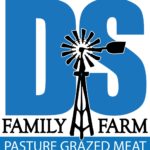Worried about what you are "really" eating? Have peace of mind with pasture grazed meats.
Grazing ice cream grass
In our solar powered steer post we described how cattle will select the tips of plants first, grazing to capture the highest amount of energy available. We call this grazing off the “ice cream”. Here is a video link from this past weekend of the herd entering a new patch and grazing the tips off what some would call weeds (we call them forbs and our cattle love them) – Instagram Video – Grazing Plant Tips For Energy @dsfamilyfarm.

Almost all plants have some part of “ice cream” (high energy) but one native plant has been nick named the “ice cream grass” – eastern gamagrass (tripsacum dactyloides). I first became interested in eastern gama during the summer of 1985 while working in Falls City Nebraska for the Soil Conservation Service. This area of the state still had small native stands of eastern gama. The story goes that grazing ice cream grass by early settlers cattle almost wiped the grass out. Since the 1990’s seed has become readily available and we have reintroduced this native grass in higher moisture soils that were previously invaded by non-native bromegrass and reeds canary grass.

In the photo above the cattle are milling around waiting to move to a fresh patch. Note this almost solid stand of eastern gamagrass has been evenly grazed to about cow shoulder height. The herd has grazed the highest energy part of the leaves and left the rest. We could “force” the herd to keep eating down the remaining leaves but if we move, two good things happen:
- The cattle move to fresh grass and eat the “ice cream” (high energy part) of the ice cream grass.
- The grass we leave behind as shown above, has good leaf area ready to capture photosynthesis and start regrowth.

In the above photo we have let down the temporary poly fence to allow the cattle to move into a fresh paddock. A win-win situation for the cattle and the grass.

Greg Judy of Missouri has a chapter devoted to eastern gamagrass in his book “Comeback Farms“, which is worth the read. He describes using a mob of dry cows to graze eastern gamagrass down further than what we show here. It just depends on your goals. In our herd we have cows with calves, yearling steers and grass finishing beef (2-year-old steers). So we are now grazing with animal condition in mind. This winter after the grass finished beeves are harvested, we will graze a little more with the land in mind.
As we have stated before our herd is 100% pasture grass-fed, no grain feeding. One unique note about eastern gamagrass is that it is believed to be related to maize (corn). The root systems are not similar at all. The leaves of eastern gama are wide like corn and take a look at the seed head in the photo below. Note that above the seed, the male portion of the plant is similar to a corn tassel. The seed is large but harder than a kernel of corn. None the less I am sure our cattle consume some of these ice cream grass seeds:
- It helps spread the plant around the pastures
- It is the closest thing to corn our cattle will ever consume!





